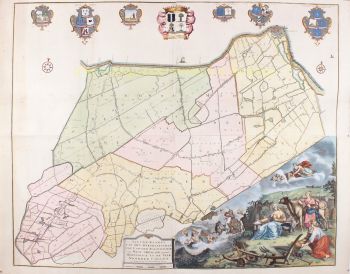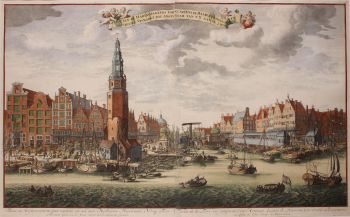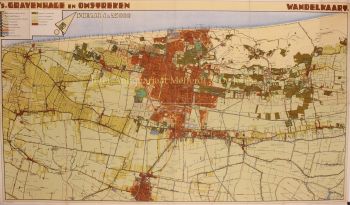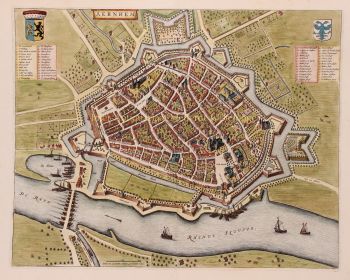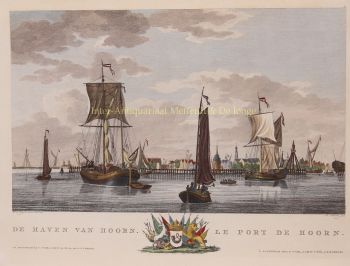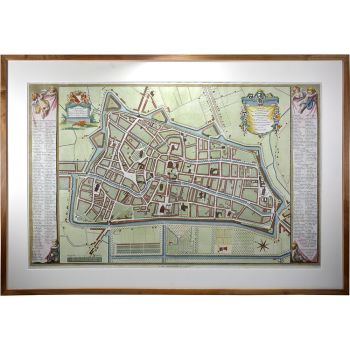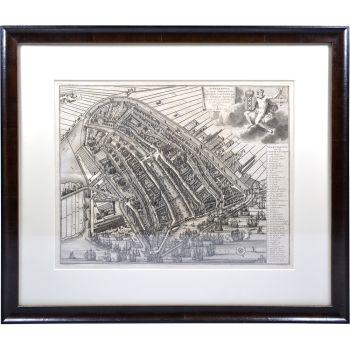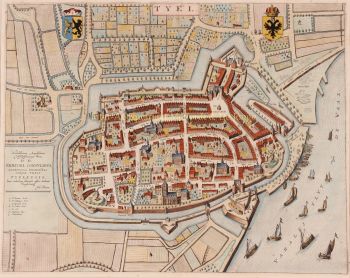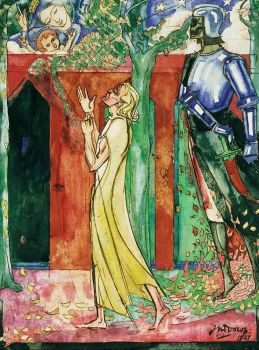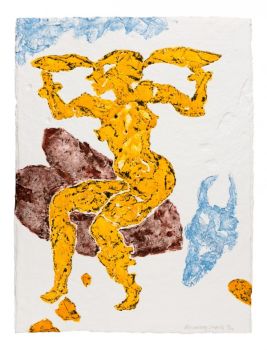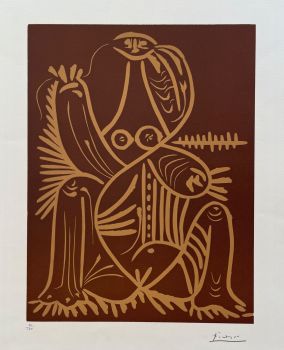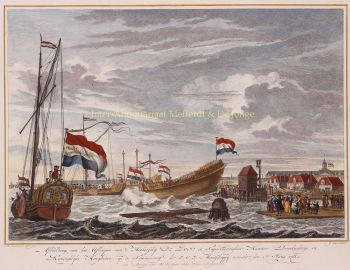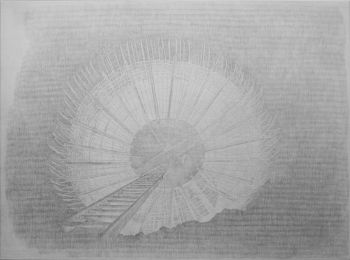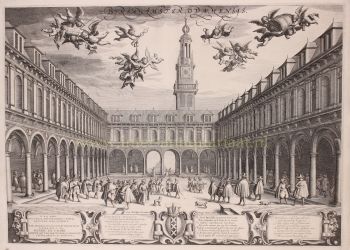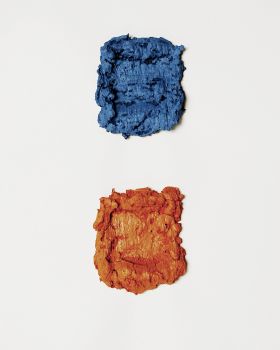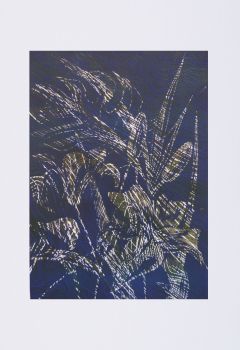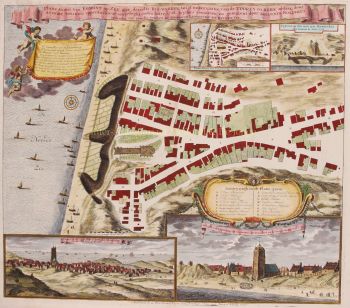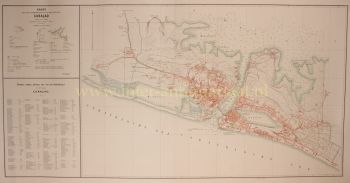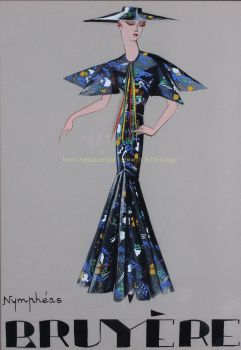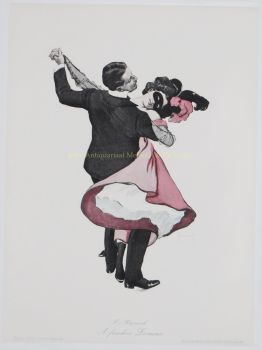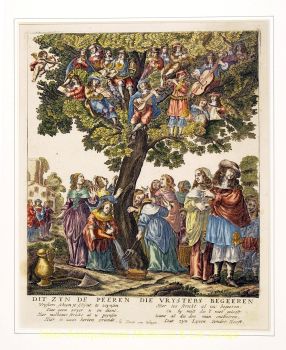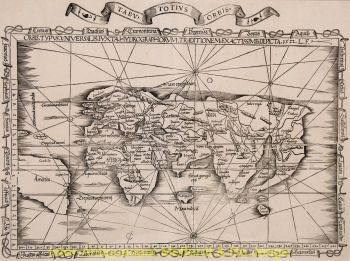Amsterdam 1783
Hendrik Leth
€ 2.250
Inter-Antiquariaat Mefferdt & De Jonge
- Sobre la obra de arte
PLAN TRES EXACT DE LA VILLE FAMEUSE MARCHANDE D'AMSTERDAM. Copper engraving printed on two sheets by Hendrik de Leth, published 1783. Measures 57.5 x 88 cm. On 24 and 27 April 1734, the following advertisement appeared in the Amsterdamsche Courant: "Te Amsterd. By Hend. De Leth on the Beurssluys, is now published, an entirely new and accurate Plan of the city of Amsterdam, with many additions that were not found in any previous plans; decorated on both sides with the coats of arms of the Wel-Ed. en Groot Agtb. Heeren Burgemeesteren deezer stad, zedert de Reformatie tot nu, door voorname Liefhebbers keurig nagezien". One could choose between a rich version with family coats of arms and the coats of arms of the Amsterdam mayors on both sides, and a plain version without the coats of arms. This copy is the version without the coats of arms. Hendrik de Leth had made a reliable map amidst many competitors (such as Covens & Mortier), which was very useful in the city administration. The dignified French title seems destined for a more representative function, but for the rest the print is entirely in Dutch, which was convenient for the artisans and administrative users. Under the title we read "Gravée et mis au jour Par Henry de Leth a l'enseigne du Pecheur". This can be translated as "Engraved and updated to the present day by Hendrik de Leth under the label of Visser." The shop of publisher Nicolaes Visscher II kept this name, even after his death in 1702. Hendrik de Leth and also his father Andries worked in Visscher's shop when he was still alive. After Visscher's death his widow Elisabeth Verseyl continued the business until 1726. From about 1720, however, the daily management was in the hands of Andries. After he took over the business, he maintained the shop's well-known name. After his death in 1731, Hendrik, the son of Andries, took over. He too continued with the same shop name. The map is extremely clear and uncluttered, with only the main buildings standing out. Hendrik de Leth made the map after an older example and provided it with completely new decoration. An interesting difference between the map by De Leth and the earlier one is that De Leth gave the buildings engraved in the uprising a shadow. The sunlight here comes from the left, which corresponds to the eastern morning sun. To the left of the decorative, opening curtain, we see a Caarte van Amstelland. It is striking that in the legend block in the top right-hand corner, an I is mentioned after nine buildings. The legend explains this with the words NB Daar een I bystaat betekent Jansenisten. Jansenism, named after Cornelis Jansenius (1585-1638), was a religious and political movement from the seventeenth and eighteenth centuries that developed mainly in France as a reaction to certain developments in the Catholic Church and to the absolutism of the rulers of those days. The Jansenists' way of life was characterised by their ascetic rejection of the world and their pessimistic ethics. They also rejected, among other things, papal infallibility. The accentuation of the buildings on the map that had a relationship with Jansenism suggests that the engraver and publisher Hendrik de Leth adhered to this political movement. The central representation under the map is designed with care and taste. The title plate is beautifully incorporated into a group of figures, in which the city virgin is flanked by the two lions of the city arms and the river gods of Amstel and IJ, while Fortuna rises from the sea. The compass rose and ruler, like the title, have been given a three-dimensional shape as part of this grouping. The city seal and coat of arms above the map are carried by two angels. Literature: Marc Hameleers - Maps of Amsterdam 1538-1865, nr. 114 p.228-231 Price: Euro 2.250
- Sobre el artista
Hendrik de Leth (Ámsterdam, 31 de mayo de 1703 - Ámsterdam, 17 de junio de 1766) fue un grabador, grabador, cartógrafo, dibujante, librero, comerciante de arte, editor de grabados, coleccionista de arte y coleccionista de naturalia.
Hendrik de Leth era hijo de Andries de Leth (cortaplatos, librero, 1662-1731) y Nelletje Middenheespen. Hendrik tenía un hermano mayor, Christiaan de Leth. En 1742, Hendrik se casó con Sophia Otto, quien murió en 1753. Su matrimonio no tuvo hijos. Era probable que el sobrino Andries, hijo del hermano de Hendrik, Christiaan, se convirtiera en el sucesor del negocio de Hendrik. Sin embargo, murió en 1743. En 1766, Hendrik de Leth hizo redactar un testamento poco antes de su muerte, por el cual Catharina le Blanc, nieta del hermano Christiaan, se convirtió en heredera. El 30 de septiembre de 1766 se realizó la subasta de su patrimonio.[3]
En 1728, Hendrik se unió al gremio de libreros. Antes de eso, fue alumno de su padre Andries de Leth, quien se hizo cargo del concesionario de mapas, grabados y arte 'Op de Beurssluys, in den Visscher' en Amsterdam del cartógrafo y grabador Nicolaas Visscher II. Hendrik de Leth a su vez se hizo cargo de esta empresa tras la muerte de su padre en 1731.
Ya en 1725, se publicó la obra Imágenes de la ciudad Wijdtvermaarde de Ámsterdam, además de sus Edificios y Gesites más importantes, todos dibujados con precisión después de la vida y publicados en Ámsterdam.
Su obra más conocida con 100 grabados se publicó en 1730: El esplendor de la bendición Kennemerlant: muestra muchos rostros gloriosos de los lugares de placer más importantes de este último, casas nobles, edificios de pueblos y ciudades: comenzando con Kastrikum (...) / dibujado después de la vida y en el cobre traído por H. de Leth; y descrito brevemente por M. Brouërius van Nidek. - Amsterdam: De Leth, 1730. Muchos grabados que De Leth hizo de Amsterdam se pueden encontrar en los archivos de la ciudad de Amsterdam.
Como cartógrafo, De Leth fue mejor conocido por su Nuevo Atlas Geográfico y Atlas Histórico, Van de Zeven Vereenigde Nederlandsche Provintien, publicado en 1740. De Leth también se hizo conocido por los grabados en cobre que realizó alrededor de 1758 del Mapa General de la Colonia o Provincia de Surinam según el diseño de Alexander de Lavaux.
¿Está interesado en comprar esta obra de arte?
Artwork details
Related artworks
- 1 - 4 / 24
- 1 - 4 / 12


